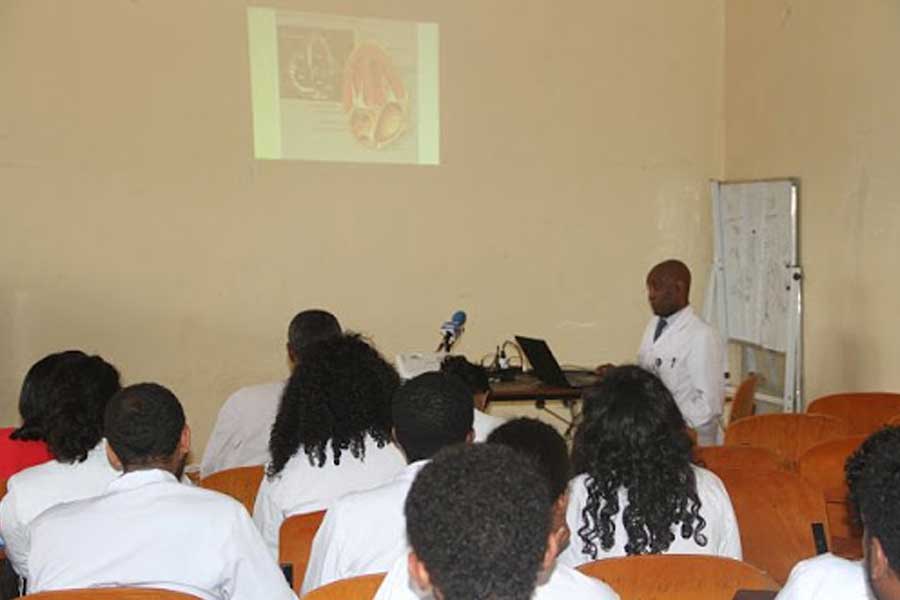
Radar | Feb 23,2019
The compound of Menelik II Referral Hospital is occupied by a large white tent that stands guard in front of an entrance to what reads Cholera Treatment Centre.
The tent housed clothes for suspected cases and patients inside the centre are obliged to wear articles of hospital clothing with hopes of preventing cross-contamination.
Treatment flowcharts are plastered around the corner.
Inside are no more than 15 beds designed particularly for patients with acute watery diarrhoea.
On one of these beds lies a 29-year-old patient with pale skin and a weary appearance revealing that she has been admitted for a while. She has IV fluid inserted on the right side of her hand.
A week prior, she had felt abdominal pain, vomiting and diarrhoea and was admitted to Wereda 6 Health Centre. She recalls the Health Centre had a special treatment unit for patients with Acute Watery Diarrhea (AWD).
But when her condition aggravated during the night, she was sent to Menelik II Referral Hospital by ambulance.
"She was unconscious when we arrived," her sister told Fortune.
The patient regained consciousness after three days, but she is unaware of how or by what she got infected. According to her, physicians advised her to limit visitors to avoid contamination.
"I was told I have acute watery diarrhoea," she told Fortune. “I didn’t know it was deadly.”
The Cholera Treatment Center set up at Menelik II Hospital two months ago has received more than 160 patients for Acute Watery Diarrhoea, characterised by extreme loss of fluid and severe dehydration. Although there were suspected cases none have been confirmed so far.
According to the United Nations Office for the Coordination of Humanitarian Affairs (UN-OCHA), over 15,685 confirmed cases and 189 deaths have been reported nationwide since August last year.
The Global Task Force on Cholera Control (GTFCC) indicates an alert should be made if two or more people from the same area are diagnosed with acute watery diarrhoea within one week of each other.
A physician from Menelik II Hospital who wants to remain anonymous believes that the diminished attention given to the case is denying the residents from taking preventive measures.
The patient flow with acute watery diarrhoea could have been managed by creating awareness in society, according to the doctor, who indicates that the lax attitude is resulting in spreading contamination.
"It’s becoming costly," said the physician.
According to the doctor, an increased number of cases result in sharing medical equipment like dialysis machines which affect other clinical procedures. Instead, the lack of equipment including personal protection equipment (PPE) for health workers plagues the hospital.
The rapid loss of body fluids can lead to electrolyte imbalances and severe dehydration, hypovolemic shock and unconsciousness while mortality which subsides below one per cent if treated can spike up to 50pc when left untreated.
"We were told it is nothing more than an emergency with nothing to declare," said the doctor.
The Head of the Bureau Yohannes Chala (MD) declined to comment on the matter where nothing has been declared.
Officials at the Ministry of Health indicated that the Ethiopian Public Health Institute (EPHI) handles emergency public health matters.
Mesfin Wossen, a public health emergency management coordinator at EPHI, said the rainy season often poses public health concerns as impurities are transported faster due to heavy floods.
He said they have deployed over four million doses of oral vaccines in hotspot areas such as religious sites in addition to providing water, sanitary products and hygiene awareness.
While Mesfin indicated that 29 new cases were reported nationwide last week, he noted that no case has been confirmed in the capital city despite the presence of treatment centres in public hospitals such as Menelik II, Yekatit 12, and Zewditu memorial hospitals.
"We need to create awareness about the danger regardless," he said.
Mesfin said the first nationwide case was reported in Harena Buluk wereda, in Bale Zone Oromia Regional State which spread to 99 woredas including Somali, Sidama, Amhara, Afar and Southern regional states through the months.
In addition to being a proxy indicator of a country's socioeconomic development, public health concerns spread through the faecal-oral route directly or through contaminated foods pose a danger to society.
The risk for transmission and spread increases with overcrowding, poor sanitation and limited water supplies.
The scarcity of equipment to treat the suspected cases adds to the problem.
In the treatment centre at Minelik Hospital, a concerned mother watches over her 16-year-old child who looks pale and weak with bags under their eyes. Despite the mother's offer of a mug of oats, the child refuses to eat or drink anything out of fear of regurgitating it.
The mother suspects that water from an unknown source has landed her child in the emergency room. But financial constraints bother her as the 290 Br additional cost for daily laboratory tests might not be affordable at some point.
"They told me the machine is not working," she said
Data from UNICEF indicates that 60-80pc of health problems in Ethiopia arise due to communicable diseases attributed to unsafe water supply, unhygienic and unsanitary waste disposal.
It entails that public health is a grave concern with nearly half of Ethiopian people having access to basic water supply, while only 8.9pc have access to sanitation space. The number dwindles further with 4.8pc having access to basic hygiene.
Experts believe that public health threats such as acute watery diarrhoea should concern policymakers where awareness creation and preventive measures prove to be more effective.
Adamu Addissie (MD), an epidemiologist at Addis Abeba University suggests working cautiously on awareness creation and campaigns on proper sanitation and drinking clean water are much better alternatives than treatment.
He presumes that reluctance to provide information comes with fear of the several economic implications but argues it should come secondary as opposed to prevention methods of communicable diseases that will possibly decrease the level of threat.
"Every second matters," he told Fortune.
With an estimated population density of 7,324.6 individuals in a square kilometre, Addis Abeba remains in grave danger of harbouring public health concerns which could have a much less impact with preventive measures.
PUBLISHED ON
Aug 05,2023 [ VOL
24 , NO
1214]

Radar | Feb 23,2019

Fortune News | Jun 19,2021

Fortune News | Dec 19,2020

Obituary | Mar 13,2021

Radar | Apr 13,2025

Viewpoints | Sep 24,2022

Commentaries | Apr 20,2019

Radar | Jul 02,2022

Fortune News | Mar 20,2021

Radar | May 04,2025

Dec 22 , 2024 . By TIZITA SHEWAFERAW
Charged with transforming colossal state-owned enterprises into modern and competitiv...

Aug 18 , 2024 . By AKSAH ITALO
Although predictable Yonas Zerihun's job in the ride-hailing service is not immune to...

Jul 28 , 2024 . By TIZITA SHEWAFERAW
Unhabitual, perhaps too many, Samuel Gebreyohannes, 38, used to occasionally enjoy a couple of beers at breakfast. However, he recently swit...

Jul 13 , 2024 . By AKSAH ITALO
Investors who rely on tractors, trucks, and field vehicles for commuting, transporting commodities, and f...

Jul 12 , 2025
Political leaders and their policy advisors often promise great leaps forward, yet th...

Jul 5 , 2025
Six years ago, Ethiopia was the darling of international liberal commentators. A year...

Jun 28 , 2025
Meseret Damtie, the assertive auditor general, has never been shy about naming names...

Jun 21 , 2025
A well-worn adage says, “Budget is not destiny, but it is direction.” Examining t...